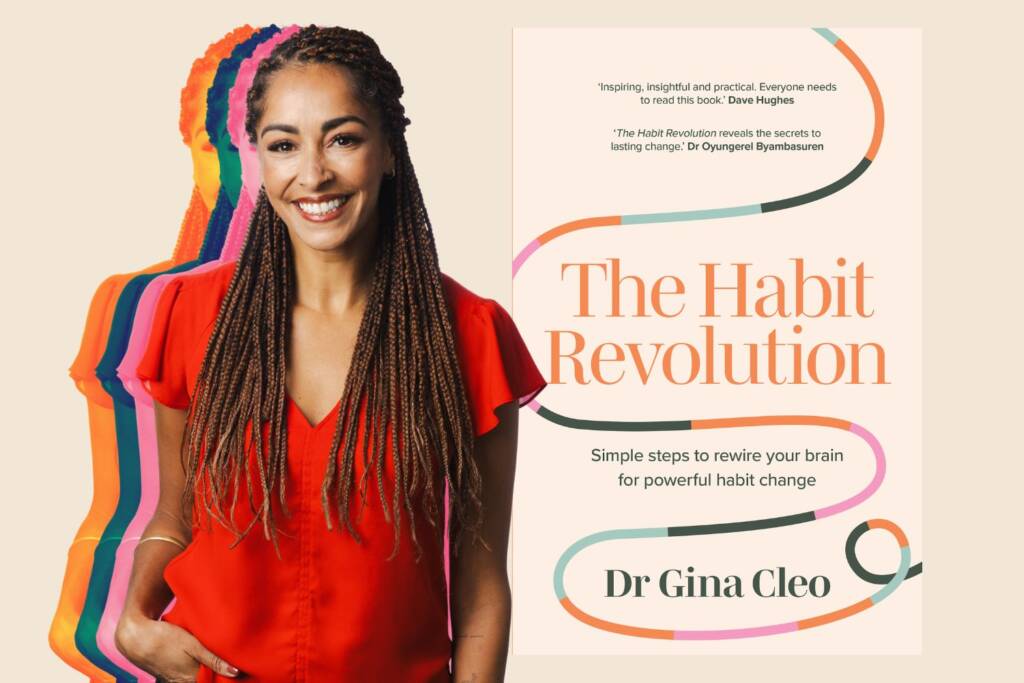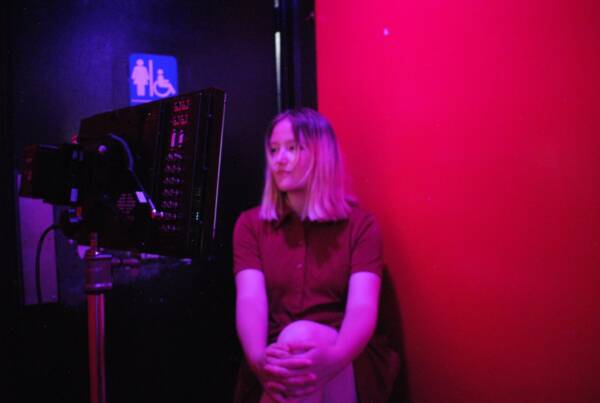Extract from The Habit Revolution by Dr Gina Cleo
 Most of us know the habits we’d like to do less of – hello, procrastination and rumination, with a side order of impulse shopping, binge eating and social media scrolling. But the thing is, most of us want to be healthier and happier and live a more fulfilled life, which requires new habits. So why is it sometimes so hard to do the things we want to do?
Most of us know the habits we’d like to do less of – hello, procrastination and rumination, with a side order of impulse shopping, binge eating and social media scrolling. But the thing is, most of us want to be healthier and happier and live a more fulfilled life, which requires new habits. So why is it sometimes so hard to do the things we want to do?
There’s a common misconception that we need to feel motivated to take action. ‘I want to start a new hobby but I’m waiting to feel motivated.’ ‘I want to save more money, but I’ll start when I’m motivated to.’ But the reality is, we get motivated as a result of taking action. Yes, that’s right, action comes first and motivation follows. Action is a prerequisite to motivation, which means that if we want to make changes in our life, we’ll often need to take action without feeling motivated to do so. It turns out that motivation is a resource we can tap into anytime. All we need to do is take the first step.
FIVE WAYS MOTIVATION IS INFLUENCED
Motivation is a complex phenomenon that is influenced by a variety of things, but it’s worth a look at these five key factors. Some may be more relevant to your situation than others.
Rewards and punishment
Reward pathways in our brain teach us that doing something will result in either a reward or a punishment. This is the essence of reinforcement learning, which helps motivate us to either increase or decrease behaviours based on the feedback we get.
Positive and negative reinforcement both help to increase a behaviour, while positive and negative punishment both help to decrease a behaviour.
Increasing behaviour through reinforcement
- Positive reinforcement: When you start making healthy changes in your life and you notice changes in your body or mindset, that gives you positive reinforcement that what you’re doing is paying off – and that increases your motivation to keep up those healthy behaviours.
- Negative reinforcement: In the opposite way, negative reinforcement occurs when the removal of something negative increases the behaviour. Let’s say you want to join a gym, for example, and for a limited time they are waiving the $200 joining fee. You’re likely to feel more motivated to join because they’ve removed a potential barrier or something ‘negative’.
Decreasing behaviour through punishment
- positive punishment: This occurs when the addition of something negative decreases a behaviour. For example, if you’ve ever burnt yourself on a hot stove, you will be motivated to not touch the flame again. Some smokers report that developing a ‘smoker’s cough’ motivates them to quit smoking.
- negative punishment: In this instance, the removal of something positive decreases a behaviour. If you’re a parent, you may have said to your child something along the lines of, ‘If you keep hitting your brother/sister, I’ll take your toy away.’ If adults consistently drive over the speed limit, they’ll lose their driver’s licence. The reason I don’t overeat dark chocolate is that the caffeine in it impacts my sleep. Removing good sleep decreases how much dark chocolate I eat.
Variable-ratio reinforcement
One surprising finding from experimental studies has been that when a behaviour is rewarded only some of the time, it tends to be stronger and more persistent than when it’s rewarded continuously. The ping of your phone is enticing because there’s an element of the unknown until you look at your phone and see who it is.
Variable-ratio reinforcement increases our motivation to persist with a particular behaviour; it creates a sense of excitement and anticipation. It’s most effective when the rewards are meaningful and the behaviour being reinforced is something we’re intrinsically motivated to do.
There’s no clear way of implementing variable-ratio reinforcement to increase our motivation, but it’s an interesting aspect of the process.
Goals
Motivation is strongly influenced by our personal values and goals. If we’re working towards something we really care about, we’re more likely to be motivated to put in the necessary effort to achieve it. Having goals can have a big impact on our motivation. This is because goals:
- direct our attention and focus
- give us energy to act and move forward (Research has shown that having a goal increases the level of effort we’re willing to apply towards both physical and mental tasks.3)
- support us in enduring longer in a specific task before giving up
- encourage us to find better solutions through intentions and strategies.
Goals can be made even more motivating when we create implementation intentions – where we plan specifically where and when we’ll perform the action that will lead us towards our goal.
Dopamine
Dopamine plays a crucial role in our experience of motivation, reward, attention and pleasure. Understanding dopamine has helped us uncover so much about the inner workings of the human brain and even more about motivation. Neurotransmitters are chemicals that allow neurons to talk to one other. Like a key fitting into a lock, dopamine binds to receptors that make the neurons slightly more or less likely to fire.
For example, when we eat something really delicious, our brain releases dopamine in a region called the nucleus accumbens, which is part of the reward pathway. The dopamine creates a pleasurable sensation, a type of reward, which motivates us to repeat the behaviour so that we can experience the pleasure again.
Dopamine is often referred to as the pathway to pleasure. You may have heard of the ‘dopamine rush’ of drugs, gambling or addictive behaviour. This makes it sound as though dopamine is the chemical that makes you feel good. But it’s more accurate to say that dopamine is involved in the drive or the experience of wanting. Dopamine is what makes us desire something, but not necessarily what makes us enjoy it. Dopamine is all about anticipation; it’s about the drive towards future rewards. So it may make you desire chocolate, but it won’t necessarily make you enjoy the taste of it.
Our brains are constantly anticipating rewards and using that anticipation to guide our thoughts and behaviour. Things like being visually stimulated (such as with social media and video games), eating, achieving a goal, the anticipation of winning, when feeling connected to others, gambling, engaging in a novel or exciting activity, sex or exercise (hello, runner’s high), and learning new things, all give us a release of dopamine that reinforces the behaviour.
We know that anything that increases dopamine activity has the potential to be addictive. But what goes up, must come down. You see, pain and pleasure sit on the same seesaw in the brain. The more we stimulate the dopamine system, which makes us feel euphoric, the more we dampen the whole system.
Naturally restoring your baseline dopamine
Having low dopamine levels feels blah. You feel down and a bit blobby. It’s natural to want to seek ways to increase your dopamine quickly so you can go back to feeling energised. But instead of chasing the dopamine dragon, all you need to do is sit and wait, because the trough will resolve itself. The baseline level of dopamine you were at before the peak will come back. You may have experienced craving something sweet but found that when nothing sweet was around for you to eat the craving went away.
Sitting with that blah feeling and waiting it out will empower you to become less reliant on unhelpful stimuli – texts, notifications, beeps, likes, comments, rings, sugar, meaningless sex, thrills – that accompany living in a modern world. It’s okay to feel lonely or bored for a short period of time.
Some evidence-based strategies for naturally restoring our baseline dopamine levels include:
- getting enough good-quality sleep. This is so important. It’s recommended that we get on average seven to nine hours of sleep a night. Make sleep a priority.
- engaging in non-sleep deep rest such as yoga nidra (drginacleo.com/book), a powerful relaxation practice that has been shown to increase baseline dopamine levels by a whopping 65 per cent.8
- viewing morning sunlight. If we do this for two to 10 minutes within zero to eight hours of waking, we can increase our dopamine levels. The earlier you view sunlight after waking, the better.
- avoiding bright lights between 10 pm and 4 am, as they activate a brain region that radically reduces the amount of dopamine circulating in our system.10 If you must view lights during these hours, try to make them as dim as possible.
- doing cardiovascular exercise. Moving our body in ways we enjoy and that increase our heart rate can help restore our baseline dopamine level.11
- eating foods that contain the amino acid tyrosine, which is found in cheese, soybeans, beef, lamb, pork, fish, chicken, nuts, eggs, beans and whole grains.12 Tyrosine can be converted into dopamine, thus increasing its availability in the body.
- if you’re up to it, taking a one- to three-minute cold shower, as cold as you can tolerate.13 This is known to dramatically increase baseline dopamine for hours.
- drinking caffeine in the form of coffee or tea, which creates a mild increase in dopamine and increases the availability of dopamine receptors, so our body is more sensitive to circulating dopamine.14 Make sure to avoid caffeine after 2 or 3 pm so that it doesn’t impact your sleep.
Competing forces
We know that every habit follows the sequence of the habit loop – cue, routine and reward – meaning that every one of our habits gives us some reward. Staying up too late impacts our sleep and health, but it gives us the reward of finishing that television series we’ve been dying to watch. The amount of motivation we have to do one action can be in competition with the amount of motivation we have to do something else. Some days we might be more motivated to sleep, whereas other days we might be more motivated to stay up and watch television. Different forces compete for our motivation.
How much value you place on the options you have in front of you will have a significant impact on your motivation. My reward value for cake is higher than my reward value for fruit. If I try to resist the cake and eat the fruit instead, my self-control will deplete quickly because I’m depriving myself of what I really want. The only time the cake wouldn’t impact my level of motivation would be if it was a cake I don’t like, such as sponge cake. I’m not a huge fan of sponge cake. Give me a cheesecake any day. And that’s where the way we frame things has a big impact on our motivation. If we change our perspective, we change our experience.
I thought about how I used to love Nutella – you couldn’t leave a jar around me without guaranteeing I’d be elbow-deep in it. But then I read the ingredients breakdown of Nutella: ‘sugar (56 per cent),vegetable fat … emulsifier, flavouring’. None of that sounded very appealing. I no longer saw Nutella as delicious chocolatey goodness, and it stopped being a tempting food for me. Change your perspective and you change your experience.
Activity 1
What motivates you?
Take out your notebook or journal and respond to these prompts:
- Think of something you do in your life that you’re happy about – maybe an established healthy habit, such as exercising regularly, eating fruit and vegetables, having a good bedtime routine, or reading regularly. What motivates you to do that thing?
- Now think of a behaviour you want to establish in your life but you haven’t started on yet. What has prevented you from feeling motivated to take action towards that thing? For example, perhaps it’s a lot of effort, maybe you don’t think you have the ability to achieve it, maybe it feels too big.
Activity 2
Making a motivation diagnosis
Use this activity to consider how motivated you are to initiate, maintain or cease a particular behaviour. Repeat the activity for each habit you want to change.
- Do you think that the benefits of starting the habit outweigh the costs?
- Are you willing to prioritise the habit over other habits if necessary?
- Do you see the habit as normal/acceptable?
- Do you have an effective plan for performing the habit?
- Are you confident in your ability to perform the habit?






